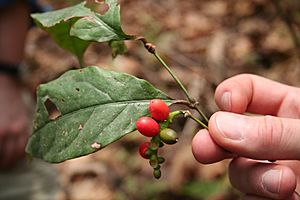Eru facts for kids
Quick facts for kids Eru |
|
|---|---|
 |
|
| Gnetum africanum, from the coastal rainforest of Cameroon. | |
| Scientific classification | |
| Genus: |
Gnetum
|
| Species: |
africanum
|
Gnetum africanum (also known as eru or African jointfir) is a special type of vine. It grows naturally in the warm, wet parts of Africa. Even though it has leaves, this plant is a gymnosperm. This means it's related to pine trees and other conifers.
People in many African countries grow and use Gnetum africanum. It has different names depending on the place. For example, in Cameroon, it's called Eru or okok. In Nigeria, it's known as ukazi or afang. Some people even call it 'wild spinach' because its leaves are eaten like a vegetable.
Contents
What Gnetum africanum Looks Like
Gnetum africanum is a wild vine that can grow very long, up to 10 meters! It's a perennial plant, meaning it lives for many years. Its leaves are thick and feel a bit like paper. They usually grow in groups of three. Each leaf can be about 8 centimeters long.
When the vine is fully grown, it makes small, cone-like parts for reproduction. The seeds look like small, fleshy fruits. They are about 1 to 1.5 centimeters long. When they are ripe, these seeds turn a bright red-orange color.
Where Gnetum africanum Grows
You can find Gnetum africanum mostly in the humid tropical forests of Central Africa. This includes countries like Cameroon, Gabon, Republic of the Congo, and the Democratic Republic of the Congo. It grows well in both untouched forests and areas where forests are regrowing.
This vine likes places that are shady, not too sunny. It can grow from sea level up to 1200 meters high. You'll often see it climbing on trees in the middle or lower parts of the forest.
Gnetum africanum can grow all year round. It spreads in two main ways. It can grow from underground stems called rhizomes. New shoots also grow from parts of the stem that have been cut. Since it's a wild forest vine, it grows best in shaded areas. Too much direct sunlight can actually burn the vine's leaves. It also doesn't grow well in very wet places like swamps.
How Gnetum africanum is Grown
Because Gnetum africanum loves shade, it can be grown alongside other trees. For example, farmers could grow it with rubber or oil palm trees. However, it needs specific conditions: shade but not too much moisture. This might make it hard for some farmers to grow if they don't have suitable land.
The good news is that this vine is not hard to take care of. Since it grows from rhizomes, it doesn't need a lot of physical work. This allows farmers to focus on other tasks.
To grow it sustainably, farmers should regularly pick the leaves instead of pulling up the whole vine. This helps the plant keep growing and provides income all year. Experts have found that it's easier to grow new plants from stem cuttings than from seeds. Cutting seedlings is a practical way to harvest without destroying the whole plant.
Organizations like the Centre for International Forestry Research (CIFOR) help women farmers. They teach them how to grow Gnetum africanum in a way that helps the forest. For example, in Cameroon, they help remove harmful plants. Then, they plant Gnetum africanum in their place. This helps the forest recover and provides a useful resource.
What Gnetum africanum is Used For
Farmers in Cameroon can improve their lives by growing this vine. It helps them get better nutrition. It also helps their environment, social life, and money situation.
The leaves of Gnetum africanum are mostly used as a vegetable. They are popular in soups and stews, often called eru soup or afang soup. You can find the leaves sold in markets all year. They can be cooked or even eaten raw.
Besides food, the leaves can be used as medicine. They might help with nausea (feeling sick to your stomach) or sore throats. They can also be used on warts. The stem of the plant can be eaten to help reduce pain during childbirth. The plant also has a root that can be eaten as a famine food, similar to a yam. Even the seeds can be cooked and eaten!
Gnetum africanum is a good source of protein. It has many important amino acids, which are building blocks for your body. It's also high in iodine, which is important for your health. The dried leaves have a lot of fiber, which helps with digestion. Studies show that Gnetum africanum can help fight inflammation and may have properties that protect against cancer.
Economically, Gnetum africanum helps farmers earn extra money. It's available all year, which makes it a steady source of income. Healthy leaves that are thick and waxy are worth the most in markets. This plant is not taxed in local markets. Since its leaves and roots can be eaten, it also helps families have enough food.
Gnetum africanum and People
Most of the Gnetum africanum grown and sold is handled by women farmers. They make up about 80% of the trade for this crop. Even though it's still often gathered from the wild, growing it on farms saves women a lot of time. They don't have to search for it in the forests anymore.
See also
 In Spanish: Gnetum africanum para niños
In Spanish: Gnetum africanum para niños
Images for kids





